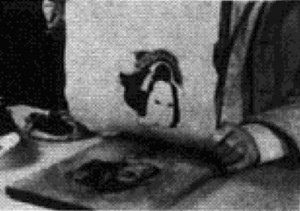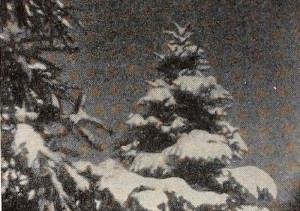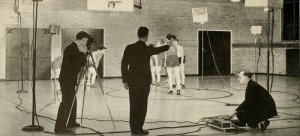"Winged Hickory on the high snow-covered slopes in the area of Aspen, Colorado (not far from Denver) is a nostalgic piece of winter ski sports by Theodore H. Sarchin. Aspen is a famous old, deserted silver mining town that has been rejuvenated by ski enthusiasts taking advantage of the excellent slopes and weather conditions. The ski lift is the longest in the world. It requires 40 minutes to ride its full length, in two sections, to an elevation of 11,300 feet. There are beginner and novice trails and challenging slopes for the experienced skier. There are vistas of the towering snow-covered mountains as well as activities in camp. During one of the Gala Days, Mr. Sarchin photographed some unusually expert skiers, such as one on tall stilts, and four men on two long skis, sort of like four men on a horse. The beauty and grace of the skiers, speeding along with the snow feathering out behind, make the rugged beauty of the terrain an outstanding picture. The background music is well chosen and Mr. Sarchin's narration is adequate" PSA Journal, Nov. 1957, 53.
"Wire and Cable Manufacture, made by Robert F. Gowen, ACL, is a good example of what can be done with the presentation of heavy manufacturing processes. The many fine shots of large machines in motion as well as of rolling hot copper ingots were striking in their beauty. A careful record of the entire process of making a giant cable was worked out on short notice and was photographed in a short time. Many difficult lighting problems were overcome, and the result is an achievement that will do credit to the manufacturer's reputation and will add prestige to Mr. Gowen's cine fame." Movie Makers, Dec. 1935, 553, 555.
"The Wonder Trail, 1000 ft., 35mm., filmed by Ralph C. Wildes, has also met with the approval of professional critics, for it has been released as a professional short subject and has received general praise. One reviewer wrote, "The Wonder Trail is an unforgettable picture; the restful, sheer beauty of it is an experience in entertainment." This is high praise, indeed, for an amateur picture since it must be remembered that the reviewer was comparing it with the hundreds — even thousands — of professional short subjects released each year. It is a scenic built from sequences of the Grand Canyon, Yosemite and the Redwood forests of California. Its photography is superlatively good and rare artistic judgment was exercised in the selection of camera viewpoints to effect beautiful compositions and to emphasize the dramatic value of mountains, falls and trees. The quality of the film's continuity lies in the leisurely sequences which display skill and care in both planning and editing." Movie Makers, Dec. 1931, 658
"Wonderland Trails is a triumph of treatment over the subject matter. K. G. Stephens, ACL, has used with sensitive artistry the space and time saving devices of closeup synecdoche, lap dissolve and the fade in, telling his charming tale of a mountain hike that went astray. On this simple framework he has presented a series of lovely scenic views, always well photographed and often superior in their crisp beauty. Smart editing serves throughout to reinforce the values of this film, which is distinguished by an imaginative and careful advance planning." Movie Makers, Dec. 1933, 523.

"Wood block printing is one of the highest forms of art in Japan. It was first introduced into that country 2000 years ago, from China. With hammer and chisel, various cuts are made in the wood block to create the pattern to be printed. A separate block is cut for each hue. The form of each block is inked and impressed upon the paper or cloth or obtain the complete print. The picture takes us gently stimulate our interest in the art of wood block printing. we are privileged to see some of the exquisite prints. The narrator's voice with its oriental flavor adds a delightful touch to the picture. This will be included in the Package" PSA Journal, Oct. 1962, 34.

"With a sensitive feeling for nature's changing patterns, even in her least productive season, Herman E. Dow has captured the flavor and beauty of New England's quiet countryside in Woods and Waters of Winterland. Closeups of streams trickling through icebound banks and selective compositions of snow-laden boughs and bleak branches contribute to the overall theme of a pleasant scenic study. A musical accompaniment for the film is well chosen and recorded." Movie Makers, Dec. 1952, 341.
"Work of Nature–in Florida takes us to this tropical state for a glimpse of many forms of wild life including the ever present alligator and the night prowling raccoon, but mostly this is a film about bird life. We see good glimpses of the snowy egret, the wood duck, night heron, hawk, wood stork, cormorant, little blue heron, grackle, macaw, cockatoo, peacocks and many others. A good narration, well delivered and full of factual information, keeps this film moving. It was winner of the MPD Nature Film Award" PSA Journal, Sept. 1964, 50.
"Work of Nature–The Micro-Aquatic Realm takes us to the Appalachian mountain region of the United States where, in not more than 18 inches of water, and at times aided by a microscope, we meet soft water snails, flatworms, protozoan organisms of one cell and multi-cell, small flies, water skimming spiders, one of over 700 species of fresh water mites less than 1/10 of an inch in length, cyclops 1/15 of an inch, and a little crab scarcely 1/25 of an inch" PSA Journal, Sept. 1965, 50.

"Y West Side, the joint production of Robert Coles, ACL, who directed the film, and Charles Coles and Edwin Schwarz, ACL, who photographed it, is a very successful publicity picture for the West Side Y. M. C. A. in New York City. Starting with the social and dormitory facilities of the "Y," the film carries the audience on a tour of gymnasiums, special exercise rooms, roof courts and pools. The abundance of athletic and exercise equipment is shown clearly in sequences of their use, and the carefully planned action throughout the picture maintains interest and continuity. This film is distinguished by excellent photography and by the successful solution of the innumerable problems in handling large scale interiors and group action. Ingenious adaptations of games and exercises were sometimes required in order to fit the scene to the camera field, determined by the exigencies of the space available. The talents of the three producers were so integrated as to make the enterprise an outstanding success." Movie Makers, Dec. 1935, 555.
"Yellowstone by Jack W. Ruddell, FPSA, of Islington, Ontario, Canada. Jack put his past prize winning talents to good work on this beautifully done travel film. This 10 minute 16mm film was awarded an Honorable Mention" PSA Journal, Nov. 1970, 38.
Total Pages: 37